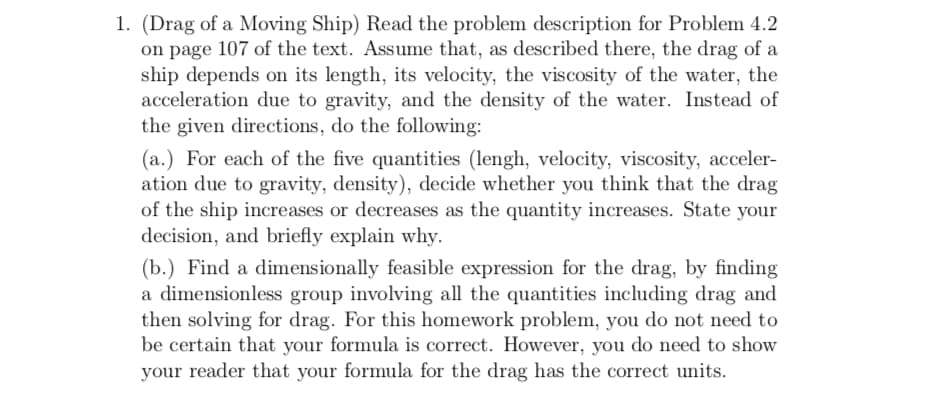1. (Drag of a Moving Ship) Read the problem description for Problem 4.2 on page 107 of the text. Assume that, as described there, the drag of a ship depends on its length, its velocity, the viscosity of the water, the acceleration due to gravity, and the density of the water. Instead of the given directions, do the following (a.) For each of the five quantities (lengh, velocity, viscosity, acceler- ation due to gravity, density), decide whether you think that the drag of the ship increases or decreases as the quantity increases. State your decision, and briefly explain why. (b.) Find a dimensionally feasible expression for the drag, by finding a dimensionless group involving all the quantities including drag and then solving for drag. For this homework problem, you do not need to be certain that your formula is correct. However, you do need to show your reader that your formula for the drag has the correct units. 4.2. The drag D of a moving ship, resulting from viscous effects and wave gener- ation, depends on its length L and velocity v, the viscosity of water u, the acceleration due to gravity g, and the density of water p. By using dimen- sional analysis, find a dimensionally feasible expression for the drag, as well as the possible dimensionless groups (T-numbers). Notice that the dimensionless groups are not unique. Discuss the physical significance of the dimensionless groups. The SI units of the quantities involved are [D] kg m/s2, [L] m, v] =m/s, [kg/(m s), [gl = m/s2, and [pl = km/m3.
1. (Drag of a Moving Ship) Read the problem description for Problem 4.2 on page 107 of the text. Assume that, as described there, the drag of a ship depends on its length, its velocity, the viscosity of the water, the acceleration due to gravity, and the density of the water. Instead of the given directions, do the following (a.) For each of the five quantities (lengh, velocity, viscosity, acceler- ation due to gravity, density), decide whether you think that the drag of the ship increases or decreases as the quantity increases. State your decision, and briefly explain why. (b.) Find a dimensionally feasible expression for the drag, by finding a dimensionless group involving all the quantities including drag and then solving for drag. For this homework problem, you do not need to be certain that your formula is correct. However, you do need to show your reader that your formula for the drag has the correct units. 4.2. The drag D of a moving ship, resulting from viscous effects and wave gener- ation, depends on its length L and velocity v, the viscosity of water u, the acceleration due to gravity g, and the density of water p. By using dimen- sional analysis, find a dimensionally feasible expression for the drag, as well as the possible dimensionless groups (T-numbers). Notice that the dimensionless groups are not unique. Discuss the physical significance of the dimensionless groups. The SI units of the quantities involved are [D] kg m/s2, [L] m, v] =m/s, [kg/(m s), [gl = m/s2, and [pl = km/m3.
Related questions
Question
100%
please help, i had the math and mechanical engineering expert help but they said that this problem is not in the right category so i wanted to know if you can help
this is for mathematical modeling
thank you

Transcribed Image Text:1. (Drag of a Moving Ship) Read the problem description for Problem 4.2
on page 107 of the text. Assume that, as described there, the drag of a
ship depends on its length, its velocity, the viscosity of the water, the
acceleration due to gravity, and the density of the water. Instead of
the given directions, do the following
(a.) For each of the five quantities (lengh, velocity, viscosity, acceler-
ation due to gravity, density), decide whether you think that the drag
of the ship increases or decreases as the quantity increases. State your
decision, and briefly explain why.
(b.) Find a dimensionally feasible expression for the drag, by finding
a dimensionless group involving all the quantities including drag and
then solving for drag. For this homework problem, you do not need to
be certain that your formula is correct. However, you do need to show
your reader that your formula for the drag has the correct units.
![4.2. The drag D of a moving ship, resulting from viscous effects and wave gener-
ation, depends on its length L and velocity v, the viscosity of water u, the
acceleration due to gravity g, and the density of water p. By using dimen-
sional analysis, find a dimensionally feasible expression for the drag, as well as
the possible dimensionless groups (T-numbers). Notice that the dimensionless
groups are not unique. Discuss the physical significance of the dimensionless
groups. The SI units of the quantities involved are [D] kg m/s2, [L] m,
v] =m/s, [kg/(m s), [gl = m/s2, and [pl = km/m3.](/v2/_next/image?url=https%3A%2F%2Fcontent.bartleby.com%2Fqna-images%2Fquestion%2Fa995208d-f6d2-42b6-9983-7feae35f3dd9%2Fe01cf451-6d08-4ae7-af01-eabb72ef22ad%2Fwjqh21o.jpeg&w=3840&q=75)
Transcribed Image Text:4.2. The drag D of a moving ship, resulting from viscous effects and wave gener-
ation, depends on its length L and velocity v, the viscosity of water u, the
acceleration due to gravity g, and the density of water p. By using dimen-
sional analysis, find a dimensionally feasible expression for the drag, as well as
the possible dimensionless groups (T-numbers). Notice that the dimensionless
groups are not unique. Discuss the physical significance of the dimensionless
groups. The SI units of the quantities involved are [D] kg m/s2, [L] m,
v] =m/s, [kg/(m s), [gl = m/s2, and [pl = km/m3.
Expert Solution
Trending now
This is a popular solution!
Step by step
Solved in 9 steps with 9 images
